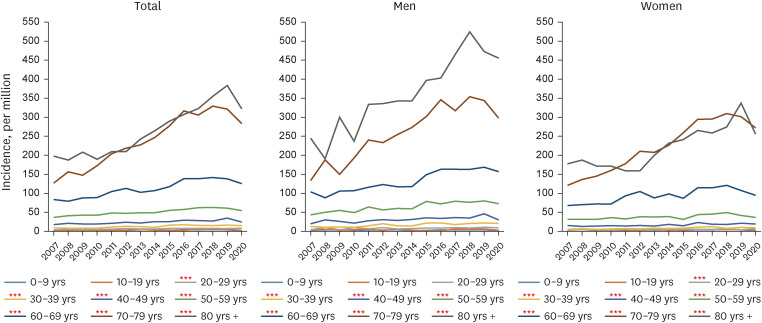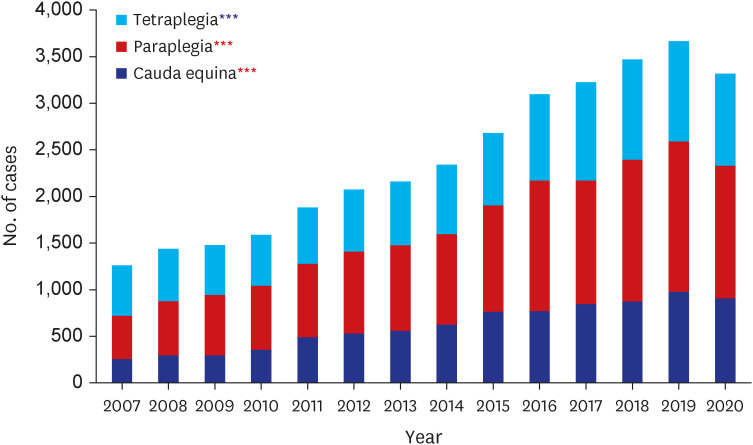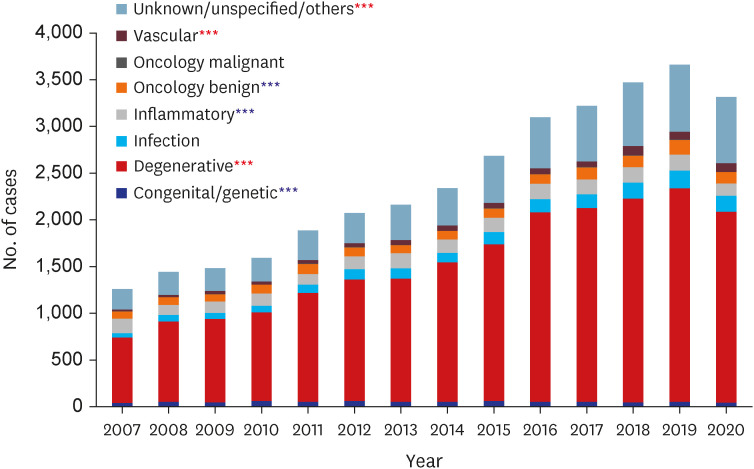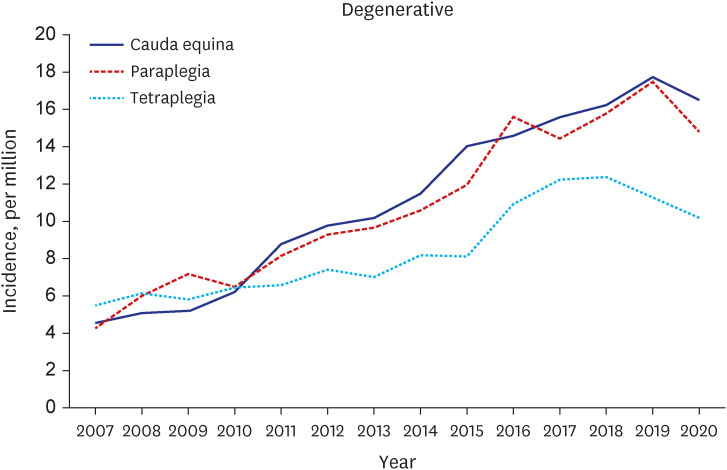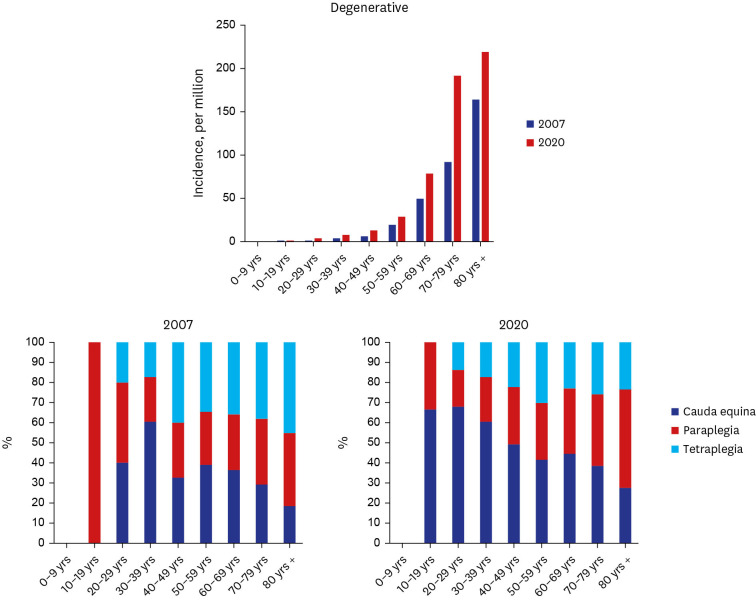J Korean Med Sci.
2023 May;38(18):e158. 10.3346/jkms.2023.38.e158.
Trends in the Incidence and Etiology of Non-Traumatic Spinal Cord Injury in Korea: A Nationwide PopulationBased Study From 2007 to 2020
- Affiliations
-
- 1Department of Rehabilitation Medicine, Seoul National University Hospital, Seoul, Korea
- 2National Traffic Injury Rehabilitation Research Institute, National Traffic Injury Rehabilitation Hospital, Yangpyeong, Korea
- 3Department of Rehabilitation Medicine, National Traffic Injury Rehabilitation Hospital, Yangpyeong, Korea
- 4Institute of Health Policy and Management, Medical Research Center, Seoul National University, Seoul, Korea
- 5Department of Public Health, Graduate School, Yonsei University, Seoul, Korea
- 6Department of Epidemiology and Health Promotion, Institute for Health Promotion, Graduate School of Public Health, Yonsei University, Seoul, Korea
- KMID: 2542033
- DOI: http://doi.org/10.3346/jkms.2023.38.e158
Abstract
- Background
Although patients with non-traumatic spinal cord injury (NTSCI) have distinct epidemiological characteristics compared to those with traumatic spinal cord injury, no previous study has reported the incidence of NTSCI on a national scale in Korea. In this study, we examined the trend in incidence of NTSCI in Korea and described the epidemiological characteristics of patients with NTSCI using nationwide insurance data.
Methods
National Health Insurance Service data were reviewed for the period from 2007 to 2020. The International Classification of Diseases, 10th revision, was used to identify patients with NTSCI. Inpatients with newly diagnosed NTSCI on their first admission during the study period were included. Crude incidence was calculated using the annual number of NTSCI cases divided by the mid-year population estimates. Age-specific incidence was calculated by dividing the number of cases in 10-year age groups by the total number of individuals in that age group. Age-adjusted incidence was calculated using direct standardization. Annual percentage changes were calculated using Joinpoint regression analysis. The Cochrane-Armitage trend test was conducted to examine the trends of NTSCI incidence according to the types or etiologies of NTSCI.
Results
The age-adjusted incidence of NTSCI increased continuously from 24.11 per million in 2007 to 39.83 per million in 2020, with a significant annual percentage change (4.93%, P < 0.05). The age-specific incidence for those in their 70s and 80s or older was the highest and rapidly increased from 2007 to 2020. According to the types of paralysis in NTSCI, the proportion of tetraplegia decreased, whereas those of paraplegia and cauda equina increased significantly from 2007 to 2020. The proportion of degenerative diseases was the largest among all etiologies and increased significantly during the study period.
Conclusion
The annual incidence of NTSCI in Korea is increasing significantly, particularly among older adults. As Korea is one of the countries with most rapidly aging population in the world, these results have significant implications, indicating that preventive strategies and sufficient rehabilitation medical services are warranted for the population of older adults.
Figure
Reference
-
1. Barbiellini Amidei C, Salmaso L, Bellio S, Saia M. Epidemiology of traumatic spinal cord injury: a large population-based study. Spinal Cord. 2022; 60(9):812–819. PMID: 35396455.
Article2. New PW, Guilcher SJT, Jaglal SB, Biering-Sørensen F, Noonan VK, Ho C. Trends, challenges, and opportunities regarding research in non-traumatic spinal cord dysfunction. Top Spinal Cord Inj Rehabil. 2017; 23(4):313–323. PMID: 29339907.
Article3. New PW, Cripps RA, Bonne Lee B. Global maps of non-traumatic spinal cord injury epidemiology: towards a living data repository. Spinal Cord. 2014; 52(2):97–109. PMID: 23318556.
Article4. New PW, Marshall R. International Spinal Cord Injury Data Sets for non-traumatic spinal cord injury. Spinal Cord. 2014; 52(2):123–132. PMID: 23295473.
Article5. New PW, Reeves RK, Smith É, Townson A, Eriks-Hoogland I, Gupta A, et al. International retrospective comparison of inpatient rehabilitation for patients with spinal cord dysfunction epidemiology and clinical outcomes. Arch Phys Med Rehabil. 2015; 96(6):1080–1087. PMID: 25743728.
Article6. Smith É, Fitzpatrick P, Lyons F, Morris S, Synnott K. Epidemiology of non-traumatic spinal cord injury in Ireland - a prospective population-based study. J Spinal Cord Med. 2022; 45(1):76–81. PMID: 32406815.
Article7. Halvorsen A, Pettersen AL, Nilsen SM, Halle KK, Schaanning EE, Rekand T. Non-traumatic spinal cord injury in Norway 2012-2016: analysis from a national registry and comparison with traumatic spinal cord injury. Spinal Cord. 2019; 57(4):324–330. PMID: 30552411.
Article8. Choi Y, Kim YE, Leigh JH, Lee YS, Kim HK, Yi YG, et al. Comparison of trends in the incidence of traumatic spinal cord injury in daily life, automobile accidents, and industrial accidents: a national multi-insurance study. J Korean Med Sci. 2023; 38(7):e26. PMID: 36808542.
Article9. New PW, Sundararajan V. Incidence of non-traumatic spinal cord injury in Victoria, Australia: a population-based study and literature review. Spinal Cord. 2008; 46(6):406–411. PMID: 18071356.
Article10. Noonan VK, Fingas M, Farry A, Baxter D, Singh A, Fehlings MG, et al. Incidence and prevalence of spinal cord injury in Canada: a national perspective. Neuroepidemiology. 2012; 38(4):219–226. PMID: 22555590.
Article11. New PW, Farry A, Baxter D, Noonan VK. Prevalence of non-traumatic spinal cord injury in Victoria, Australia. Spinal Cord. 2013; 51(2):99–102. PMID: 22665222.
Article12. Choi Y, Kim EY, Sun J, Kim HK, Lee YS, Oh BM, et al. Incidence of depression after traumatic brain injury: a nationwide longitudinal study of 2.2 million adults. J Neurotrauma. 2022; 39(5-6):390–397. PMID: 34931535.
Article13. Kim HK, Leigh JH, Lee YS, Choi Y, Kim Y, Kim JE, et al. Decreasing incidence and mortality in traumatic brain injury in Korea, 2008-2017: a population-based longitudinal study. Int J Environ Res Public Health. 2020; 17(17):6197. PMID: 32859061.
Article14. Jeon I, Leigh JH, Ro JS, Ro YS, Lee SH, Shin HI, et al. Trends in the incidence of work-related traumatic limb amputations in South Korea from 2004 to 2013. Prosthet Orthot Int. 2019; 43(4):409–417. PMID: 30922171.
Article15. He W, Goodkind D, Kowal P, Almasarweh IS, Giang TL, Islam MM, et al. Asia Aging: Demographic, Economic, and Health Transitions. Suitland-Silver Hill, MD, USA: U.S. Census Bureau;2022.16. Cheol Seong S, Kim YY, Khang YH, Heon Park J, Kang HJ, Lee H, et al. Data resource profile: the national health information database of the National Health Insurance Service in South Korea. Int J Epidemiol. 2017; 46(3):799–800. PMID: 27794523.
Article17. Song SO, Jung CH, Song YD, Park CY, Kwon HS, Cha BS, et al. Background and data configuration process of a nationwide population-based study using the Korean national health insurance system. Diabetes Metab J. 2014; 38(5):395–403. PMID: 25349827.
Article18. Yoon HK, Park C, Jang S, Jang S, Lee YK, Ha YC. Incidence and mortality following hip fracture in Korea. J Korean Med Sci. 2011; 26(8):1087–1092. PMID: 21860561.
Article19. Jaglal SB, Voth J, Guilcher SJ, Ho C, Noonan VK, McKenzie N, et al. Creation of an algorithm to identify non-traumatic spinal cord dysfunction patients in Canada using administrative health data. Top Spinal Cord Inj Rehabil. 2017; 23(4):324–332. PMID: 29339908.
Article20. Kim HJ, Fay MP, Feuer EJ, Midthune DN. Permutation tests for joinpoint regression with applications to cancer rates. Stat Med. 2000; 19(3):335–351. PMID: 10649300.
Article21. McCaughey EJ, Purcell M, McLean AN, Fraser MH, Bewick A, Borotkanics RJ, et al. Changing demographics of spinal cord injury over a 20-year period: a longitudinal population-based study in Scotland. Spinal Cord. 2016; 54(4):270–276. PMID: 26458974.
Article22. Derrett S, Beaver C, Sullivan MJ, Herbison GP, Acland R, Paul C. Traumatic and non-traumatic spinal cord impairment in New Zealand: incidence and characteristics of people admitted to spinal units. Inj Prev. 2012; 18(5):343–346. PMID: 22544829.
Article23. Lee BS, Kim O, Ham D. Epidemiologic changes in nontraumatic spinal cord injury for the last 30 years (1990-2019) in South Korea. Spinal Cord. 2022; 60(3):268–273. PMID: 34453110.
Article24. Shin JC, Kim DH, Yu SJ, Yang HE, Yoon SY. Epidemiologic change of patients with spinal cord injury. Ann Rehabil Med. 2013; 37(1):50–56. PMID: 23525183.
Article25. Kim HS, Lim KB, Kim J, Kang J, Lee H, Lee SW, et al. Epidemiology of spinal cord injury: changes to its cause amid aging population, a single center study. Ann Rehabil Med. 2021; 45(1):7–15. PMID: 33557481.
Article26. Yoon D, Kim KE, Lee JE, Kim M, Kim JH. Impact of the coronavirus disease 2019 (COVID-19) pandemic on medical use of military hospitals in Korea. J Korean Med Sci. 2021; 36(28):e204. PMID: 34282607.
Article27. Kang E, Yun J, Hwang SH, Lee H, Lee JY. The impact of the COVID-19 pandemic in the healthcare utilization in Korea: analysis of a nationwide survey. J Infect Public Health. 2022; 15(8):915–921. PMID: 35872432.
Article28. Lee DY, Yang JH, Ki CH, Ko MS, Suk KS, Kim HS, et al. Relationship between bone mineral density and spinal muscle area in magnetic resonance imaging. J Bone Metab. 2015; 22(4):197–204. PMID: 26713311.
Article29. Karsy M, Chan AK, Mummaneni PV, Virk MS, Bydon M, Glassman SD, et al. Outcomes and complications with age in spondylolisthesis: an evaluation of the elderly from the quality outcomes database. Spine (Phila Pa 1976). 2020; 45(14):1000–1008. PMID: 32097272.30. Majid K, Fischgrund JS. Degenerative lumbar spondylolisthesis: trends in management. J Am Acad Orthop Surg. 2008; 16(4):208–215. PMID: 18390483.
Article31. Deer T, Sayed D, Michels J, Josephson Y, Li S, Calodney AK. A review of lumbar spinal stenosis with intermittent neurogenic claudication: disease and diagnosis. Pain Med. 2019; 20(Suppl 2):S32–S44. PMID: 31808530.
Article32. Issack PS, Cunningham ME, Pumberger M, Hughes AP, Cammisa FP Jr. Degenerative lumbar spinal stenosis: evaluation and management. J Am Acad Orthop Surg. 2012; 20(8):527–535. PMID: 22855855.33. Ide M, Ogata H, Tokuhiro A, Takechi H. Spinal cord injuries in Okayama Prefecture: an epidemiological study ’88-’89. J UOEH. 1993; 15(3):209–215. PMID: 8378665.
Article
- Full Text Links
- Actions
-
Cited
- CITED
-
- Close
- Share
- Similar articles
-
- Epidemiology of Traumatic and NonTraumatic Spinal Cord Injury in Korea: A Narrative Review
- Comparison of Outcome between Patients the Traumatic and Non-traumatic Spinal Cord Injured
- Urinary calculi in traumatic spinal cord injury
- Epidemiologic Change of Patients With Spinal Cord Injury
- Spinal Cord Injury Fact Sheet in Korea

